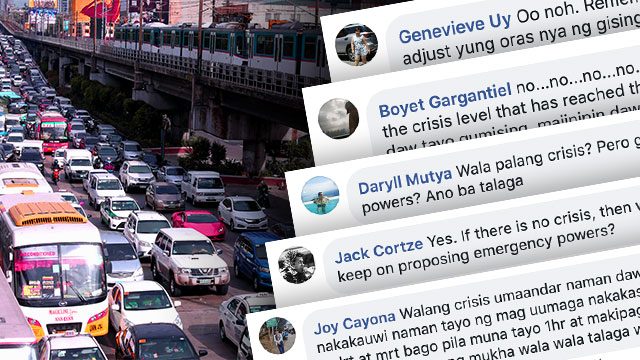SUMMARY
This is AI generated summarization, which may have errors. For context, always refer to the full article.

MANILA, Philippines – Has our country’s transportation problem hit rock bottom?
Netizens got triggered and insisted in showing the everyday ordeal of commuters to Presidential Spokesman Salvador Panelo, after he denied there was a mass transportation crisis. Panelo’s point was that commuters were still able to reach their destinations despite the monstrous traffic and arduous rides. He also suggested for commuters to wake up early in order to arrive at their destination on time.
Following backlash from public officials, progressive groups and ordinary commuters, Panelo has since agreed to take the jeepney and Light Rail transit (LRT) to Malacañang on Friday, October 11, to experience the daily hardships faced by Filipino commuters. (READ: [OPINION] No, Mr Panelo, there is a traffic crisis and denying it won’t help)
A solution to a ‘nonexistent crisis’
This was not enough for netizens. They voiced their thoughts on social media and pointed out that the government’s denial of the crisis was unacceptable. Several users cited the government’s plans and attempts to acquire emergency powers to solve the intractable traffic problem.
The Department of Transportation (DOTr) had previously asked for emergency powers on behalf of President Rodrigo Duterte to help untangle the worsening traffic in the National Capital Region. The DOTr withdrew its request in September, saying traffic management was not part of their mandate.
“Marami talagang Pilipino na puro kontra kaya di umaasenso ang Pinas eh,” wrote Wowie Pangilinan.
(Lots of Filipinos contradict themselves, which is why the Philippines hasn’t made any progress.)
Others questioned why the government was nitpicking the use of the word “crisis.”
Hitting Panelo’s suggestion to leave early to avoid the traffic rush, many netizens shared how their worst commutes lasted for several hours, despite waking up well before rush hour. Dar Win Di believed the agonizing long commutes prove there is a transport crisis.
Albert Lorna Buenviaje believes the public’s daily struggles are enough to warrant a crisis, without the government’s confirmation.
“When you see and experience the crisis, you do not need a transportation expert or a Malacañang clown to confirm there is a crisis,” he said.
Meanwhile, MJ Guinto III questioned why the government would rather wait for the traffic problem to worsen before addressing it.
“Nakakarating pa rin sa pupuntahan pero hihintayin pa ba na hindi na nakakarating bago umaksyon?” he asked.
(Commuters can still arrive to their destinations, but do we want to wait until this is no longer possible before we act?)
What’s causing the problem?
Rather than denying the crisis, netizens believe the government should determine which factors contributed the most to the country’s transportation problem in order to find realistic solutions to traffic.
A number of netizens felt Metro Manila was too congested, and that decentralization might alleviate the traffic situation in the metro.
“Siguro kung naka-spread ang mga work sa iba’t ibang lugar, not just Metro Manila, at pareho ang rate ng sahod, malamang medyo luluwag ang EDSA at ilan pang congested na lugar,” Jan Joshua Baconawa said.
(If work areas were spread out across different places, not just Metro Manila, and workers received equal pay nationwide, EDSA and other congested areas would be decongested.)
Other netizens believed the government was not prioritizing public transportation, and was instead investing in making mobility easier for those who own private cars. Several efforts of the administration to fulfill its campaign promise to ease Metro Manila’s traffic crisis have earned the ire of many Filipinos. Among these are the Metropolitan Manila Development Authority’s (MMDA) provincial bus ban and yellow-lane policy, which commuters dubbed as anti-poor. (READ: Class divide: Filipinos slam MMDA for ‘anti-poor’ EDSA policy)
Additionally, netizens shared how several infrastructure projects under the Build, Build, Build program have made it more difficult for commuters to quickly get from one place to another. This includes the ongoing Skyway Stage 3 connecting the South Luzon Expressway (SLEX) and the North Luzon Expressway (NLEX), which causes major buildup of cars when street lanes are closed.
A number of netizens maintained that the relief to the traffic woes would unravel as soon as the infrastructure projects were completed. They urged everyone to be patient. (READ: Belmonte warns: Traffic will get worse before it will get better)
“‘Pag natapos nagawa lahat [ng infrastructure projects] medyo luluwag na ang daloy ng trapiko,” Keith Gigantone said.
(Once all these infrastructure projects are completed, traffic will be lighter.)
Here’s what other netizens had to say:
Transportation crisis – Curated tweets by rapplerdotcom
What was your worst commute like? Do you think we are now in a transportation crisis? – Rappler.com
Add a comment
How does this make you feel?
There are no comments yet. Add your comment to start the conversation.